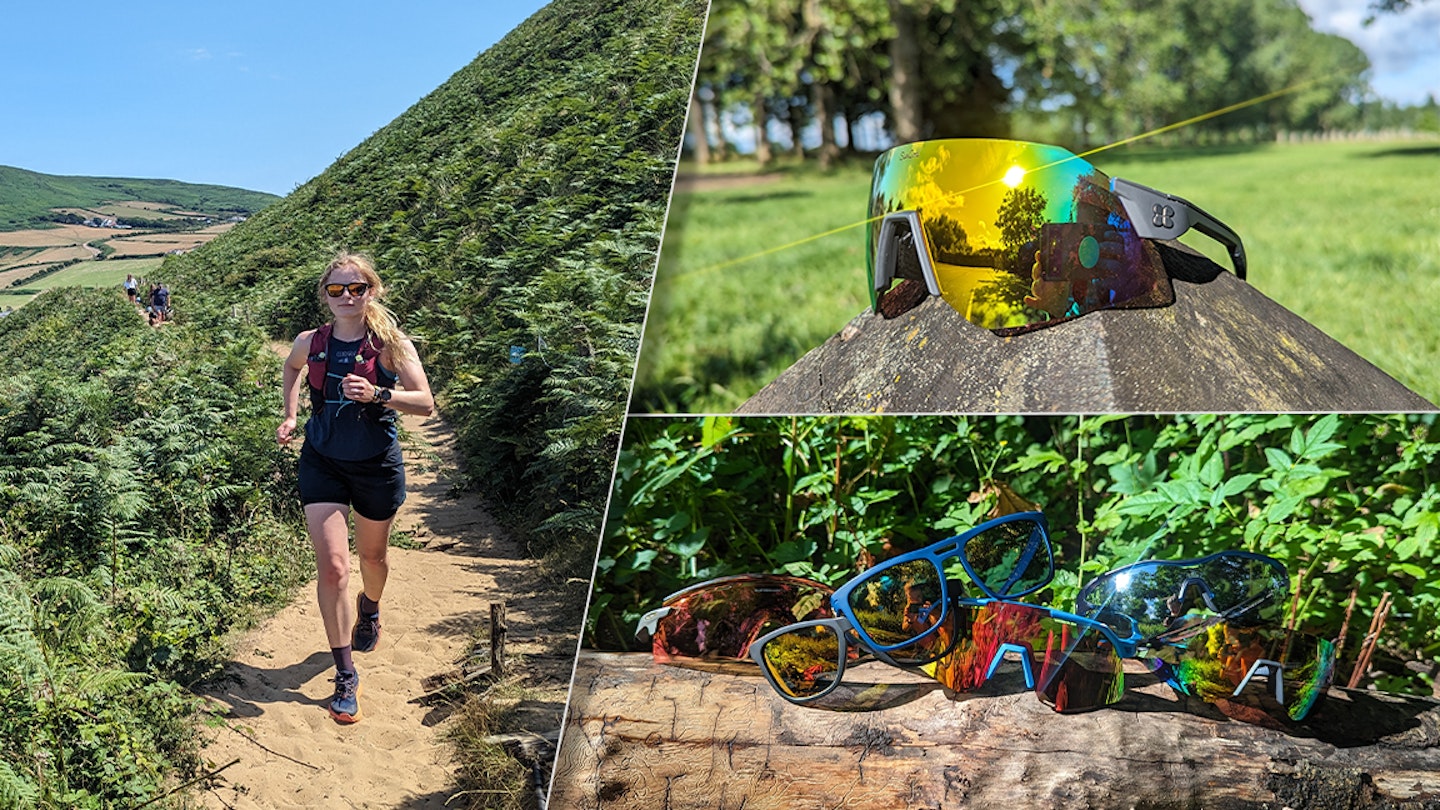Did you know that you can actually waste energy when you’re running from squinting against the sun’s rays? The best running sunglasses will not only make running in bright conditions more comfortable, but also make you a more efficient runner.
When it comes to running sunglasses, it's all about the lens. To pick the right sunnies for you, consider firstly two things. One, what conditions are you likely to be wearing them in? For instance, do you run purely on trail, in overcast conditions, in forests, or maybe along exposed paths by the beach? These different conditions will elicit different lens types for optimal running vision and eye protection.
If your route has bright light conditions, you'll need a lens with minimal light transmission. If it's also a route that has plenty of reflective surfaces such as large stretches of water, metal, snow, or tarmac, then a polarised lens will reduce the harshness of this glare. While if you're partial to some technical trails, then a brighter hue like a rose tint will increase the contrast and make smaller details easier to spot.
The last key thing to consider is the kind of style and fit you're after. Of course, a good pair of running sunglasses should feel light and immovable on your face, which is normally achieved through grippy coatings or sleeves on the frame and a minimalist build.
However, sunglasses shape and profile largely comes down to personal preference. Consider if you like a smaller lens that doesn't ellipse your whole face, or if the wrap-around pro style suits you better and you prefer that bit more coverage that comes with it. Do like a frame-free lens silhouette, or prefer the structure provided by a full frame? Ultimately, the choice is yours.
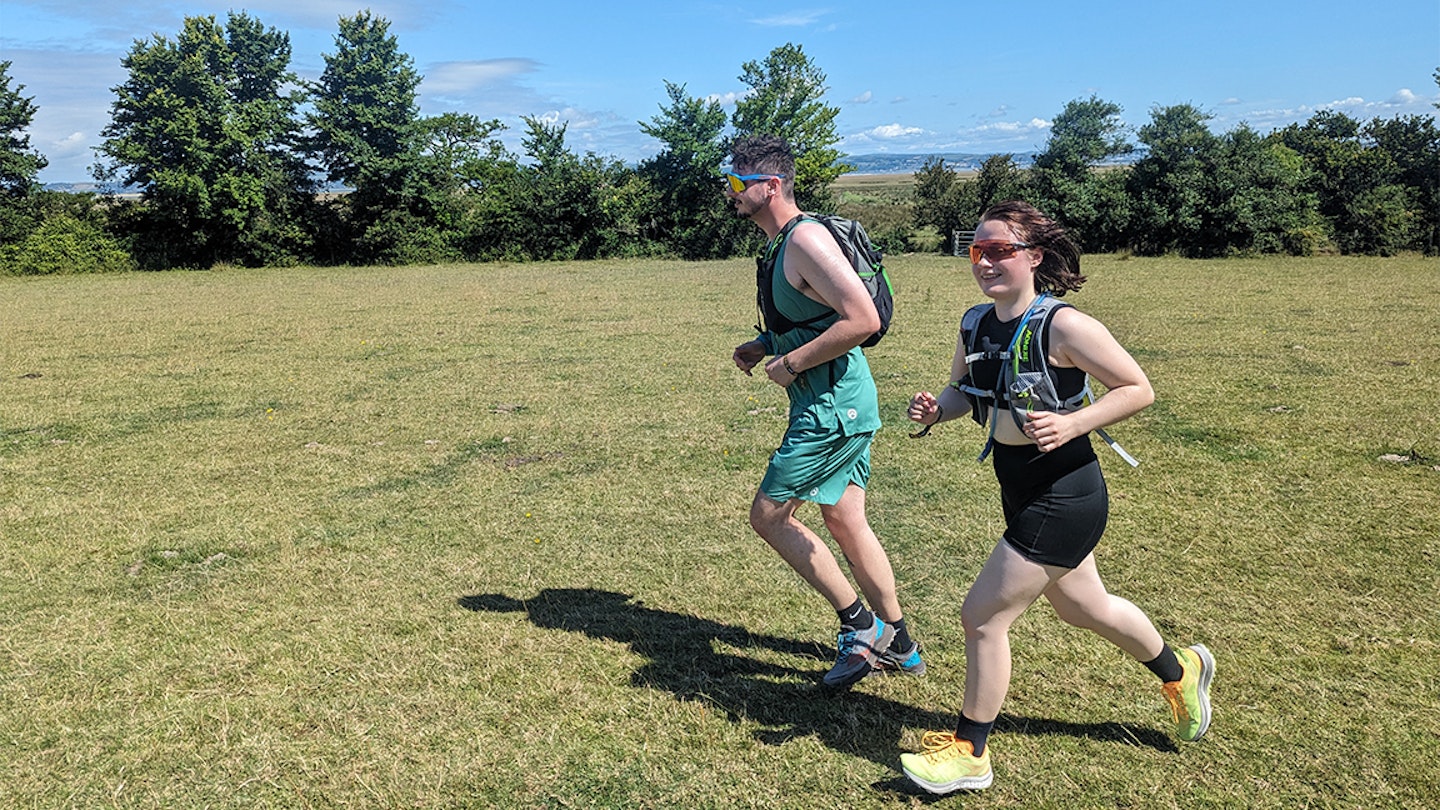
Best running sunglasses at a glance
Best on Test – Goodr OG Whiskey Shots with Satan
Best Value – Decathlon Runperf 2
Best lens coverage – SunGod Ultras
Best high performance – Dynafit Ultra Evo
In this guide, we talk through the key features of some of our favourite sunglasses for running. We've tested a range of running sunglasses in different styles, sizes, and with different lenses, to give you a good idea of the front runners when it comes to protecting your eyes on the trails. We've made sure to include some affordable options, as well as put to the test those in the high performance end of the market. Here are our findings...
Best running sunglasses in detail
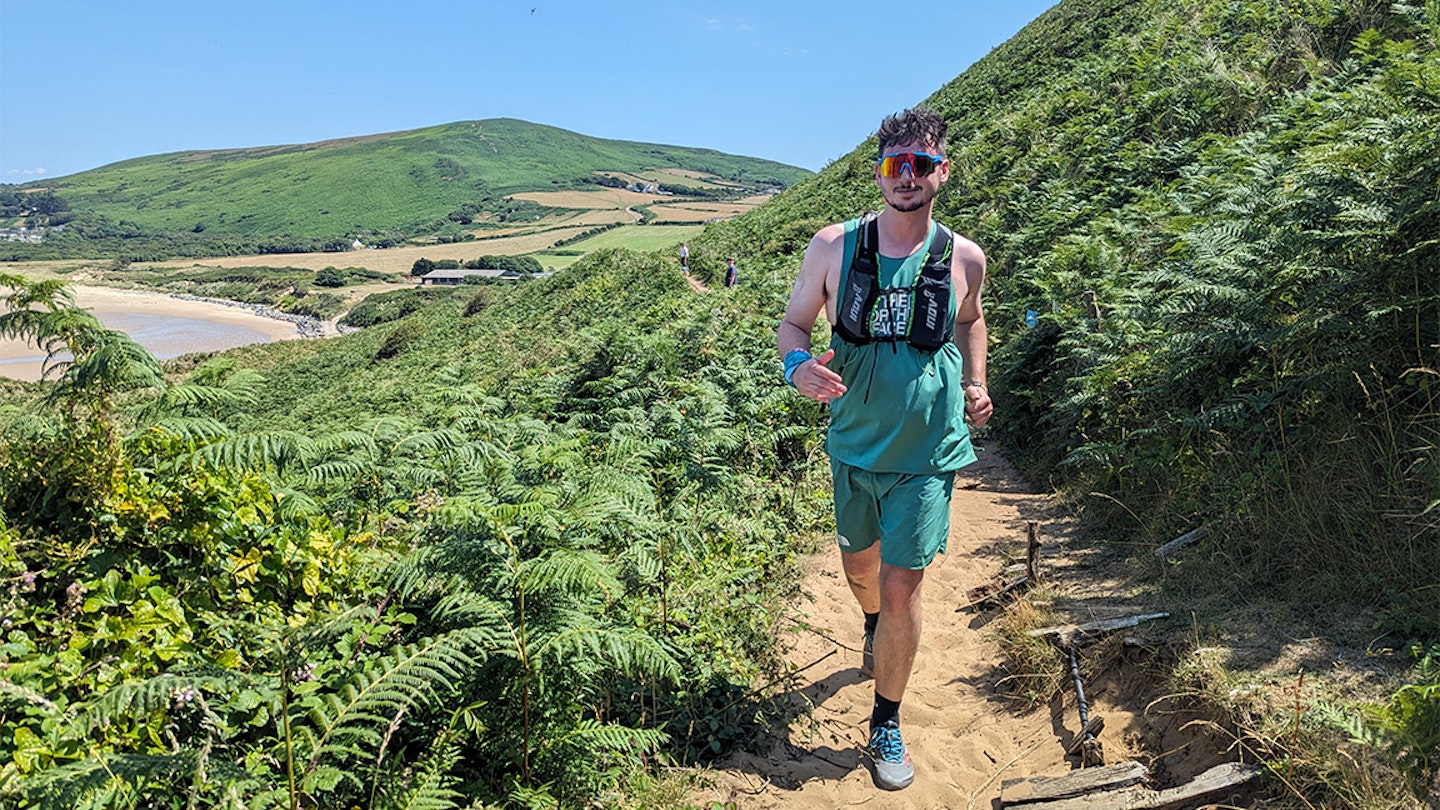
1.
Goodr OG
Best in Test
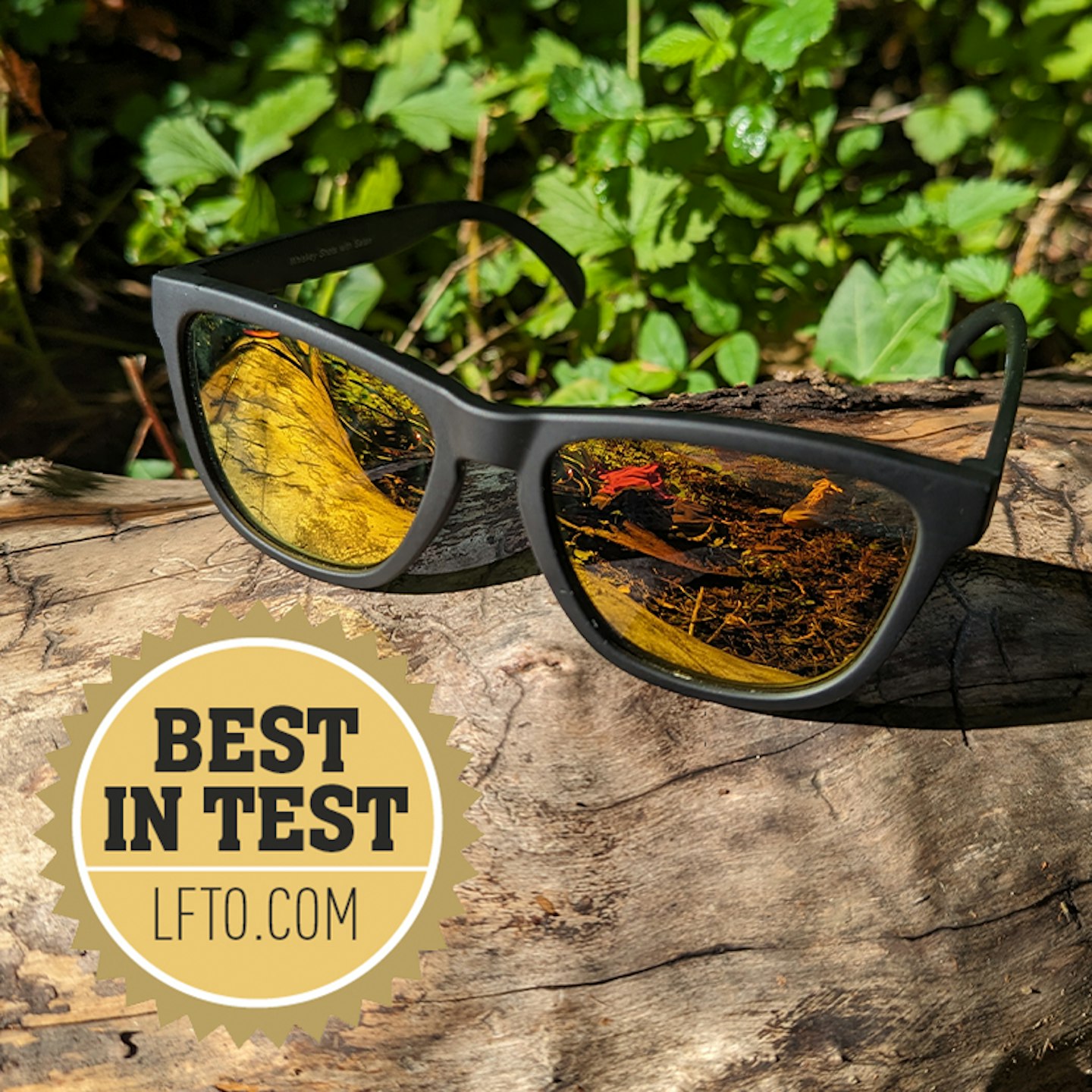
www.sportsshoes.com
Goodr is a sunglasses company committed to producing affordable and functional sunnies, as exemplified in their OG range. We’ve tested the OG ‘Whiskey Shots with Satan’ for the better part of six months and really enjoyed their classic style and feel.
Goodr do heaps of style combinations, but we liked the svelte black frame with molten amber lens of the Whiskey version and that they deliver on exactly what you need in running sunglasses, with none of the extra frills. Don't worry, if you do have a larger face then there are wider-fit options too.
Despite there being no obvious adjustability, these sunnies fit well thanks to the grippy coating and lightweight (21g) frame which stays in place beautifully when running. The Whiskey lenses are polarised, mirrored, have glare reduction, and UV400 protection. They also have a scratch-resistant coating which should increase longevity.
What's more, the company's 100% carbon neutral and a 1% for the planet member – now that's something we can get behind.
Pros
- Comfortable one-size sunnies
- Mirrored and polarised lens
- Lightweight
- Great value for money
Cons
- Coverage not as wide as a wrap-around lens
| Weight | 21g |
| Frame profile | Classic square-style |
| Lens | Mirrored and polarised, UV400 |
Best Value

www.decathlon.co.uk
The Decathlon Runperf 2 are a simply designed pair of running and cycling sunglasses. They've got a flexible half-rim frame with grey mirror effect lens that Decathlon says provides 100% UV filter protection.
The top of the lightweight (23g) sunnies have three vents, and the glasses themselves are set away from the face, elevated slightly via the adjustable nose bridge.
Running with the Runperf is easy, they stick firm to the face thanks to the rubber arm grippers and solid nose bridge. The lens does have a curve and slight wrap-around to the sides, but they don't provide full coverage to the extent of the SunGod Ultras and Dynafit Evo.
As mentioned, the lens itself is grey with 8-18% light transmission for relatively sunny weather. It also has a mirror effect on the outer surface, which Decathlon says is 'purely aesthetic'.
Pros
- Great value for money
- Slight wrap-around form
- Adjustable nose bridge
Cons
- Mirrored style just for effect
| Weight | 23g |
| Frame profile | Medium curve, top-rim frame |
| Lens | Grey, mirror effect |
Best lens coverage
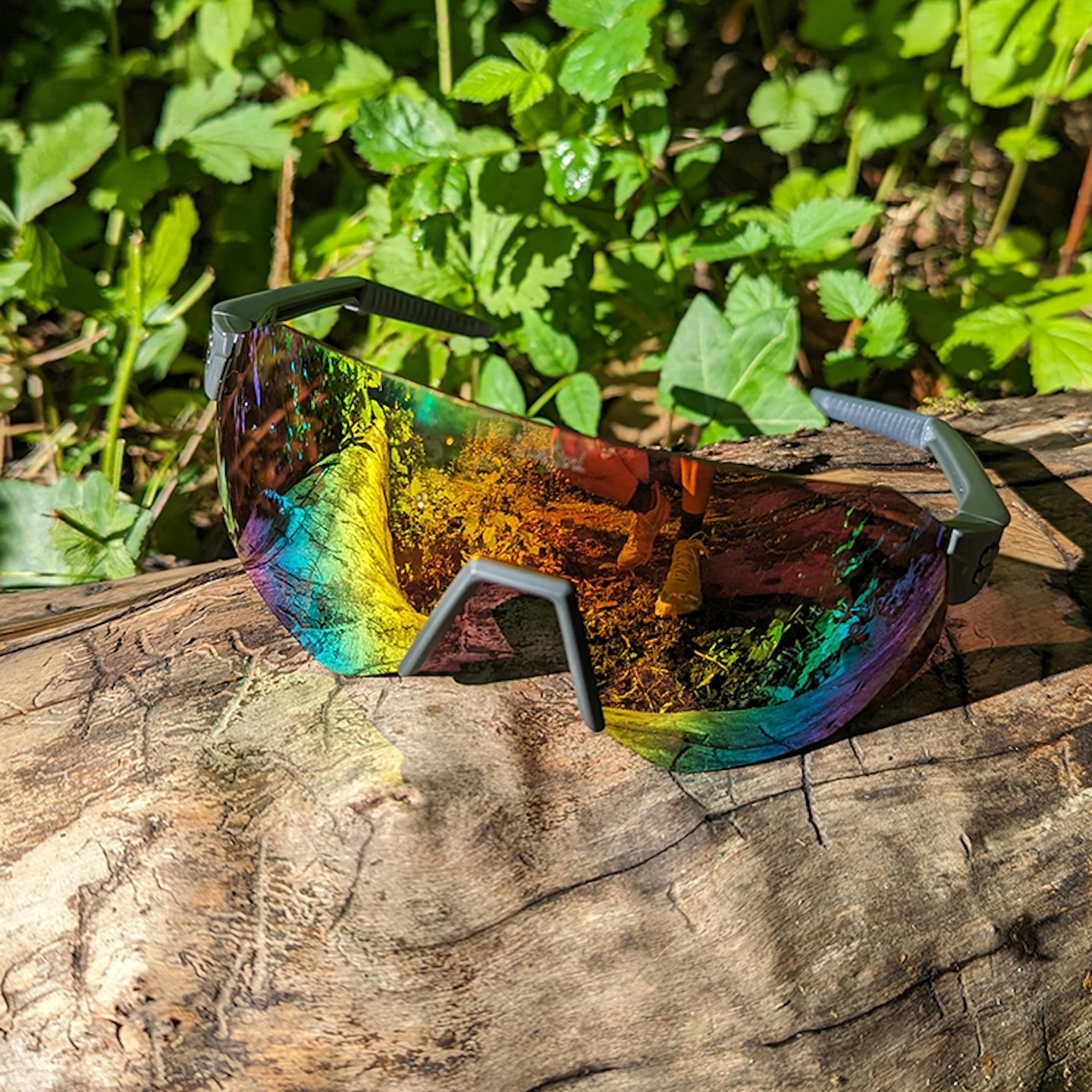
www.sungod.co
The SunGod Ultras have to be one of our favourite sunglasses to run in. It's all down to the complete coverage provided. The wrap-around, cut-out lens covers all the gaps you may notice in a normal pair on sunglasses, not letting any harmful UV rays through. With the Ultras you can fully focus on the trail ahead.
The minimalist design with no frame around the lenses cause them to hover on the face, the slight elevation from the nose bridge allowing for great ventilation and zero fogging. They're not the lightest pair of sunnies on test, but they're not far off and for the complete coverage offered, the Ultras remain massively featherlight.
The 2mm nylon lens is one deftly curved mono-lens with SunGod's 8KO technology for boosted clarity. The lens itself also has a triple-layer protection from scratches and 100% UV protection. If you normally struggle to find your right size, this shouldn't be an issue with the Ultras as they come with four different sizes of nose pad.
The best part of the Ultras is that SunGod is a certified B Corp and these sunnies are 100% carbon neutral, with a lifetime guarantee which should extend their lifespan.
Pros
- Great wrap-around lens coverage
- Sits comfortably on the face
- Grippy arms keep them in place
Cons
- Not everyone will be a fan of the large profile
| Weight | 27g |
| Frame profile | Wrap-around mono-lens, no frame |
| Lens | Multicolour mono-lens, polarised and mirrored |
Best for high performance

www.dynafit.com
If you’re going for the ultra sporty look, the Dynafit Ultra Evo fits the bill to a T. The Evo has a large profile and wrapped lens set into half-rim frames. We tested the stylish ‘frost dawn cat’ colour combination of blue casing and ombre orange lens.
In terms of lens clarity, the Evo has this in spades. Dynafit uses Italian Divel Optics to create a high contrast lens with protection against UVA, UVB and UVC rays. The wrap-around visor style is great if you want a lot of glare protection and you don't want to be distracted by a busy frame.
The whole approach with the Evo is to create a set of rigid but lightweight performance sunglasses with minimal points of contact, taking advantage of air resistance to side-step glasses fog and create your own circulatory cooling system as you plough forwards. Yes they do have an oversized look, so if you’re a minimalist at heart then take a look at our Goodr glasses review.
Meanwhile, the light weight Grilamid arms take some getting used to – our tester spent their first run worrying that the glasses were going to fling off at any moment. But, once you're familiar with the fit, the barely-there sensation becomes highly enjoyable.
The semi-encased frame protects the top ridge of the glasses, with four ventilation slits set into the top and bottom, additional slits along the arms, and even on the nose bridge, creating loads of opportunity for airflow.
For the £135 price-tag, you also get a sturdy hard case plus microfibre cloth bag. Plus, they come with a five-year guarantee.
Pros
- Wrap-around style equals lots of protection
- Structurally rigid and strong frame
- Well ventilated with no fogging
Cons
- Large profile won't be for everyone
| Weight | 31g |
| Frame profile | Half-frame |
| Lens profile | Wrap-around |
Recommended
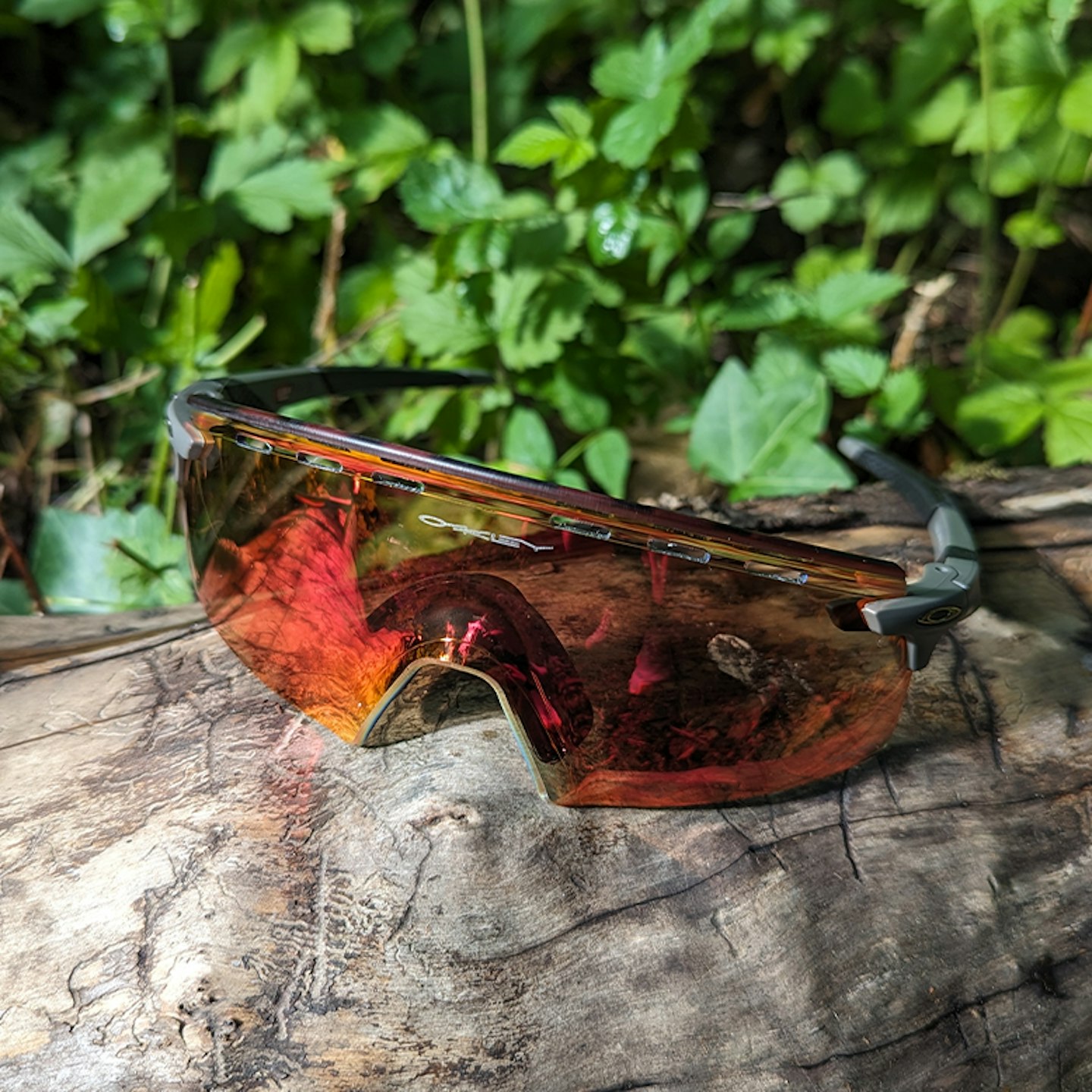
www.oakley.com
The Oakley Encoders are performance-focussed sunglasses made for functionality across various sports. The wrap lens design provides a nice and wide field of vision, protecting the eyes from the sun’s glare alongside any pesky midges and mites.
The Encoder is available with lenses of various colours, we tested the Prizm Trail Torch lens in rose which transmits 35% of light, making them best suited to medium light conditions. This felt pretty spot on, with those brighter, sunnier runs leaving a bit more glare protection to be desired. You can choose a lens with less transmission though, depending on the conditions you’re running in.
The point of the Prizm lens is that it enhances colour and contrast, which aims to provide more detailed vision. If you tend to struggle with blurry eyes when you run, the Prizm could help regain some clarity. We enjoyed the rose-tinted view when running, and the delicate tint was ideal for more overcast days when you still want to protect your eyes.
Since the top of the glasses sits relatively low across the forehead (Oakley calls this the O-Matter fit), they fit well when wearing a running cap (or bike helmet for the duathletes among us). The top of the lens also has well-placed ventilation cut-outs which do a good job of preventing the glasses misting up in use. The arms and nose also have a non-slip ‘Unobtainium’ grip to them, which is highly important when you’re bounding along the trails. These glasses do not budge.
The extra injection of impact protection should translate to further longevity as, let’s face it, the Encoder is not cheap. Sunnies aside, you’re paying for the quality and credibility wrapped up in the Oakley name.
Pros
- High contrast lens equals great clarity
- Great ventilation
- So comfortable and lightweight you forget you're wearing them
Cons
- Not for super bright conditions
| Weight | 31g |
| Frame profile | Frameless |
| Lens | Prizm Trail Torch, rose tint, wrap-around |
Recommended
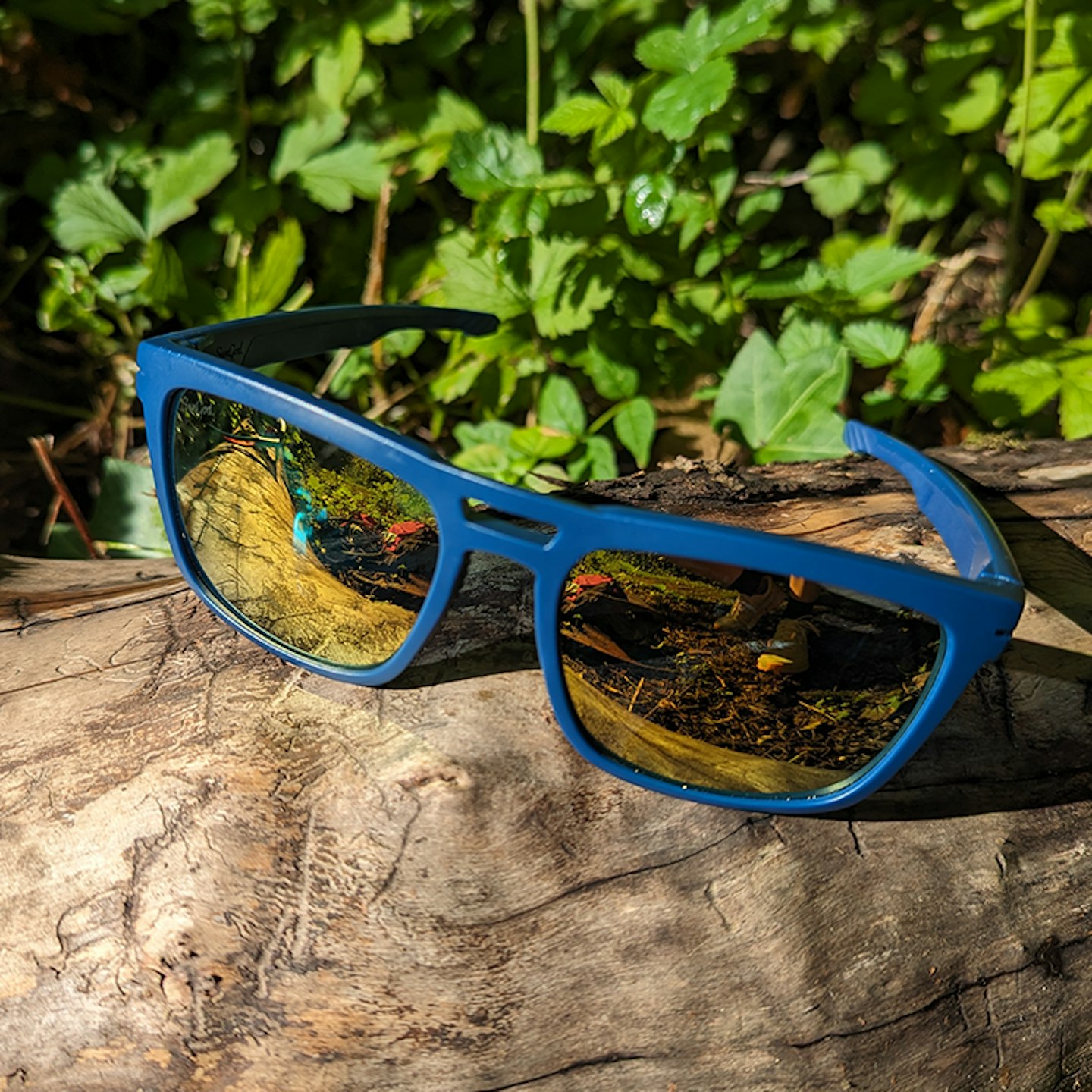
www.sungod.co
The SunGod Tempests are built to last. Designed with SunGod's 8KO lenses which aim to provide excellent clarity, the Tempests come in a wide range of lens tints. We went for the gold lens with matte navy frame.
Though the Tempests are from SunGod's Lifestyle series, they stay in place while running thanks to the 'Grip-Lock' arms and nose pads. They're on the larger side, so would be best suited to larger or wider races, and they don't have that wrap-around style so won't provide as much coverage as an option like the SunGod Ultras would.
The cherry on the top? SunGod are now a certified B Corp, making the Tempests fully carbon neutral. SunGod also follow out any repairs for free to extend their lifetime and the impact on the planet.
Pros
- Great for larger faces
- Versatile style doubles up as an everyday look
- High-performance build with mid-range price
Cons
- Might be too wide for small faces
- Not as much coverage as a wrap-around lens
| Weight | 27g |
| Frame profile | Full-frame, square-style |
| Lens | Polarised and mirrored, 100% UV protection |
Recommended
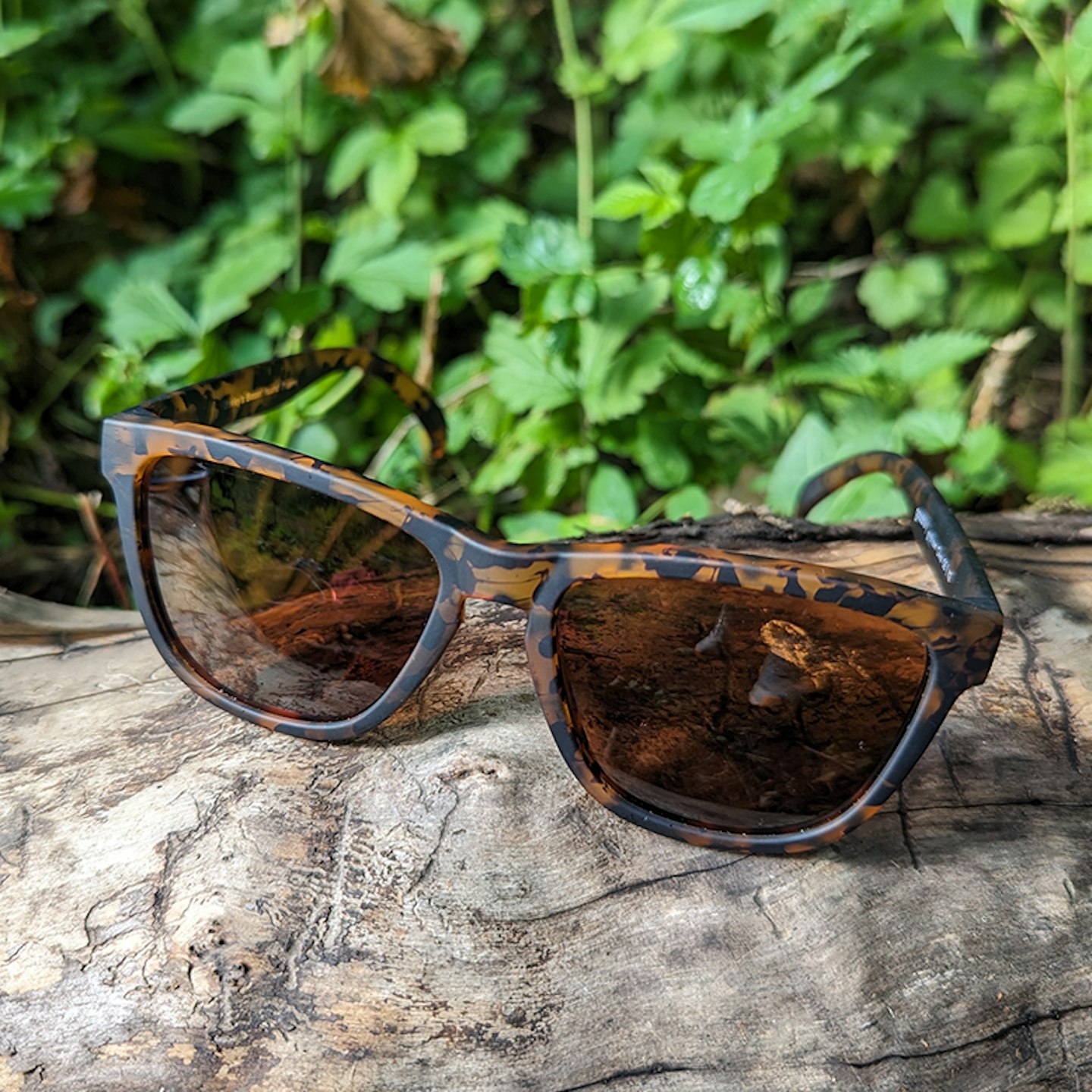
www.sportsshoes.com
The Goodr Bosley's Basset Hound Dreams running sunglasses have the exact same construction as our test-winning sunnies from Goodr, but with a different style more suited to an everyday look. We're all for this, especially for those after just the one pair of sunnies for work and play, these OG sunnies cover it all. They have polarised lenses which protect the eyes from harsh glares and bright lighting, as well as the standard UV400 rating.
The style may be reminiscent of leopard-print teenage years, but we embraced this fully and found they perform well on the trail and for hiking. The one-size frame manages to magically fit a wide range of races and nose bridges, with the grippy coating helping them stay in place once they're there.
They've also got anti-scratch coating, and sure enough after over three months of testing, there's not a mark on them (and we're not the most careful when stashing our kit).
Pros
- Double up as everyday sunnies
- Polarised and UV400 protection
- Lightest on test (21g)
- Affordable price-point
Cons
- Less coverage than others
| Weight | 21g |
| Frame profile | Classic square-style |
| Lens | Polarised, UV400 protection |
What sunglasses are best for running? Key features explained
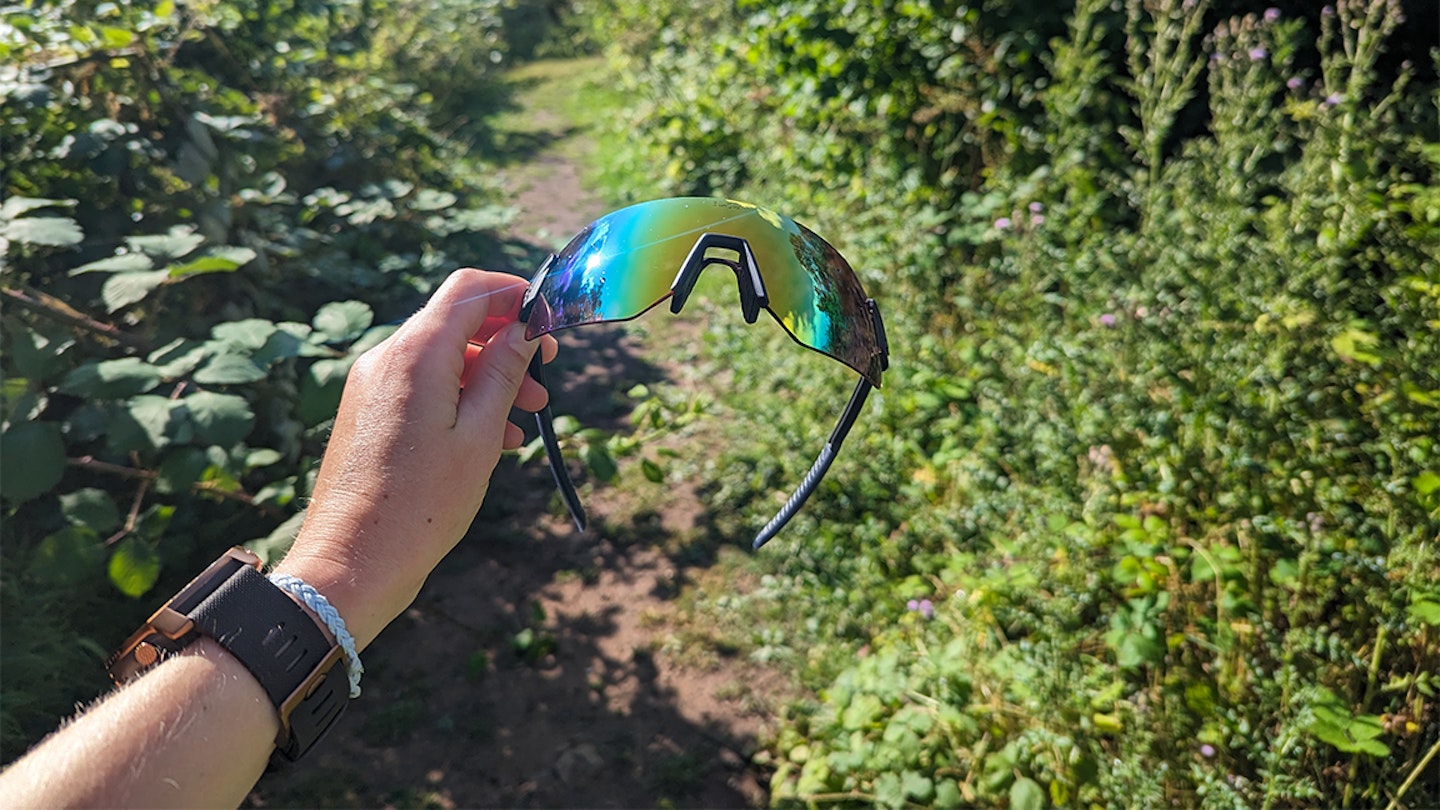
Lens – When it comes to your sunglass lens, you want to get it right. Most running and sports sunglasses lenses will be made from lightweight polycarbonate or polyurethane, while some will have additional coatings like those for anti-fog and anti-scratch. Polarised lenses are best for running in bright conditions where there's glare from reflection off lakes, the sea, or certain road surfaces. These lenses are made to reduce glare, as well as protect the eyes from UV rays. The UV protection is the most important though, so make sure your chosen sunnies have a minimum of UV400 protection.
Frame – The frame of your sunglasses should be grippy and rigid, while remaining as lightweight as possible. These days, many glasses follow a minimalist style with no framing around the lens, or a half-frame style, again to cut down on the grams.
Adjustability – Most sunglasses should have some level of adjustability, and that will normally be found in the nose piece. The glasses will either come with a nose bridge that can be bent to the right size, or multiple sizes to choose from. Not all sunnies will offer this though, with our best overall Goodr glasses coming as a one-size-fits-all pair. It's that their grippy frame coating and ergonomic design which helps them sit at just the right place.
What’s the difference between UVA, UVB and UVC rays?
There are three main types of UV radiation. Ultraviolet A (UVA) radiation has the longest wavelength with the lower amount of energy of the three types, so manages to penetrate the earth's atmosphere and through the skin's dermis. Approximately 95% of the UV radiation that reaches Earth is UVA rays. Some Ultraviolet B (UVB) rays also get through, though not as much since the wavelength is shorter. Then there are Ultraviolet C (UVC) rays, which are the most harmful, but don't penetrate the earth's atmosphere. The highest UV protection rating available for sunglasses is UV400, which block 99-100% of the sun's rays.
What colour lenses are best for trail running?
The colour of your sunglass lens isn't simply for style purposes. A darker lens may feel gentler on the eyes in really bright lights, but could lack clarity when the sun goes in and it gets darker. Whereas, rose-tinted lenses can increase contrast, bringing clarity to those more technical sections on the trail.
Are polarised sunglasses better for running?
Polarised sunglasses refer to the extra glare protection added to a lens for running in bright conditions. Polarised sunglasses are particularly useful if you tend to run along routes that have lots of reflective surfaces, like stretches of water, the road, and cars. If you stick to trails 100% of the time and don't tend to hang out by a large body of water, then you're less likely to need polarised lenses.
Are photochromic lenses good for running?
Photochromic lenses are light-adaptive, meaning they're translucent in dark light conditions, and turn a darker tint when the lighting gets brighter. They're useful for people who don't want to swap between glasses, especially if lighting conditions are constantly changing. You can even get prescription photochromic lenses.
In theory, a photochromic lens for running sounds great, and it will work well for some. But some lenses tend to not get completely dark in bright conditions, and even then, the running conditions may well call for a brighter lens for high contrast. You can't control when the lens transitions. It can take up to a minute for the lens to transition and this is slowed down by the cold. They can also be more costly than your standard sunnies.
How we test
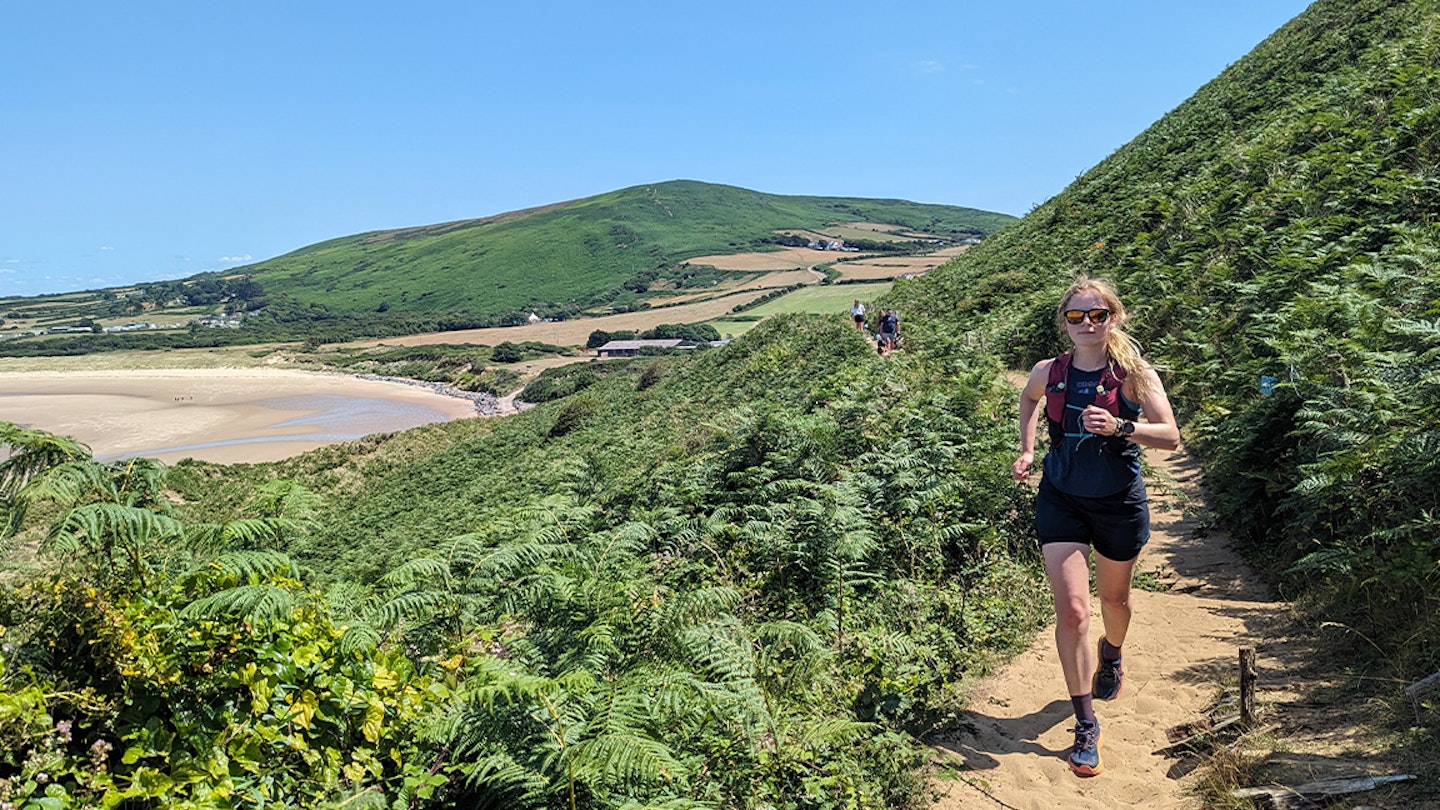
The running sunglasses we test are worn during runs across a range of light conditions, distances, and climates. As soon as we get our hands on them, we’re testing not only their run-specific capabilities, but the durability of their materials, versatility across a range of conditions and adjustability for different head shapes.
We consider multiple factors when testing running sunglasses, but most of all whether they protect your eyes from the sun’s harmful rays and stay on your face during movement. Then, there’s the less obvious but also essential factors of comfort and style which are also considered.
Kate Milsom is a Digital Content Writer for Live For The Outdoors. She specialises in running journalism and run gear testing and has a background in triathlon and cycling.
